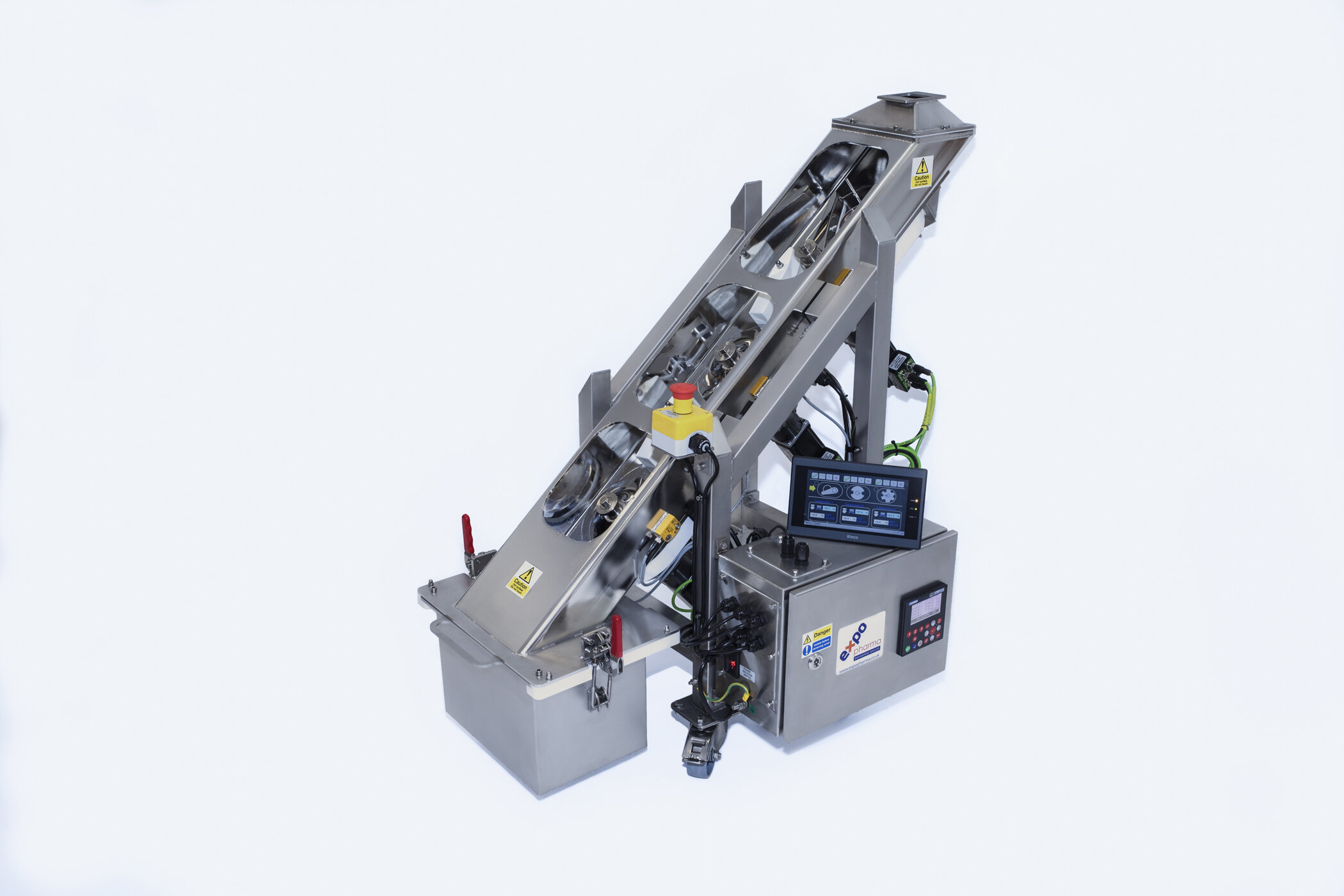ExpoPharma’s PAT Analytical Sensor Evaluation Platform Includes Mclennan supplied Motion And Machine Control Sub-System
ExpoPharma’s Spectrum Multi-Probe Chute allows multiple PAT technologies to be simultaneously evaluated as a means to economise API software related use and speed production development by providing optimum interfacing for several sensor types that economically gather high-quality data in sequence during the same process stream. The various sensors used provide precise information from the powder stream including chemical structure, identity, particle size, contamination etc.
The three positioning axes, supplied from Mclennan’s distribution partner JVL, are MIS232 series integrated microstepping motors – the novel motion control solution that combines motor, drive, controller and comms in a single package. Fitted with Mclennan’s own range of IP57-M01, 10:1 ratio planetary gear units to provide high resolution angular positioning, each drive micropositions special ‘wheels or flipper-shaped’ end-effectors that are designed to collect sample material from the powder stream and present it to the sensor being assessed through a probe window. These sensors are typically particle image analysers, Raman spectroscopy probes and a near infrared (NIR) spectrometers. For these diverse and complex analytical sensor types, the characterisation process necessitates its corresponding and different shaped end-effector to manage the sample collection (and for some a PAT probe cleaning regime) with quite different positioning sequences in terms of angular travel, speed, acceleration and deceleration.
Mclennan worked engineer-to-engineer with ExpoPharma from the early stages of product development. Through its system integration capability and experience the ‘distributed’ integrated stepper motor solution was recommended to provide cost and functional advantages, and to maintain the maximum portability requirements specified for the Multi-Probe Chute. The compact and easily installed stand-alone solution reduced ExpoPharma’s product development burden and also required much less installation effort through less cabling which furthermore simplified 1/3 commissioning. And most importantly, JVL’s integrated motor technology is proven to be inherently better protected against electrical noise, which can be a significant problem with traditional ‘centralised’ panel-mounted motion systems where power, signal and communications cabling is typically longer and noise-prone - an especially important requirement for the sensitive sensor equipment under evaluation on the platform.
Electrical installation for the JVL integrated microstepping motors, which are also available as servomotor variants, was simply achieved through on-board M12 connectors for drive power and the daisy-chained Ethernet connection to the HMI. Whilst an ‘open-loop’ microstepping motor solution was used, to boost positional accuracy and to ensure that axis position is always known on power-up (with no homing procedure required), optional absolute encoders were included and conveniently wired directly to the HMI from another M12 connector on the integrated motor. Mclennan also provided the wiring for the temperature controller – each end effector includes a heater and temperature sensor that is used to reduce the possibility of powder material sticking as well as aid the cleaning of PAT probe windows.
Mclennan’s scope of supply covered the programming and commissioning of the complete subsystem for the Multi-Probe Chute with the three motor axes part of a Modbus TCP protocol network segment which also included an MT400 series HMI from Kinco and an EMKO PIDQuadro temperature controller. The three motion axes, pre-programmed for comms interfacing and configuration, are slaved to the HMI which is assigned as the sub-network master. Using Kinco’s HMIware configuration software, Mclennan programmed a series of graphical screens that display or assign values for the positioning axes. There is also provision for manually positioning each axis with jogging and other functions to help develop specific motion sequences used during sensor evaluation. Also slaved to the HMI through the Modbus TCP network segment are the temperature controller’s display, level setting and alarm functions for each of the three end-effector mechanisms. Thus, through the HMI, each axis with its different positional and dynamic motion requirements, and corresponding end-effector temperature settings, are all easily selected, interrogated or diagnosed. As part of its system commissioning service, Mclennan supplied a complete installation and programming manual and also carried out site visits for system evaluation and acceptance testing.
With the evaluation of the various analytical sensor probes managed by ExpoPharma as a further Ethernet network segment, the complete machine combines positioning and machine control capability from Mclennan with ExpoPharma’s considerable expertise as a leading manufacturer of equipment interfaces for process based analytical sensors.
ExpoPharma are the pharmaceutical manufacturing division of expo Technologies – a global leader in engineered solutions for electrical protection by purge and pressurisation. Product information on the Spectrum Multi-Probe Chute can be found here.
Mclennan combines its own design and production capability with major motion control equipment supplier distribution partnerships where individual components or complete servo motor and/or stepper motor based motion systems including positioning mechanics and machine controls or automation software can be supplied and fully supported. For further information on Mclennan’s comprehensive range of motion control products and system integration capability, visit www.mclennan.co.uk, email sales@mclennan.co.uk or call +44 (0) 1252 531444.

